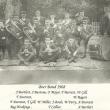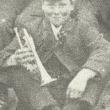Search our records : Anthony Bartlett
| Surname: | Bartlett |
| Forename(s): | Anthony |
| Service Number: | 391838 |
| Date of Birth: | 18th September 1896 |
| Force: | British Army |
| Unit: | 2/9th Battalion London Regiment (Queen Victoria's Rifles) |
| Date of Death: | 26th September 1917 |
| Where Buried / Commemorated: | Tyne Cot Cemetery |
| Civilian Occupation: | Clerk |
| Home address: |
Anthony Bartlett was born in Seaton on 18th September 1896, although the rest of his family were born in Beer. At the time of the 1901 census he was living with his family in Cemetery Lane, Beer, and by 1911 they had moved to 'Thatch Cottage', still in Beer.
After leaving Colyton Grammar School, Anthony moved away to London to work, and became a clerk in the offices of George Wills and Co., a booking agent for the Blue Funnel Line in Leadenhall Street, London. This explains why he enlisted in the Army in Kilburn, north London, rather than here in Devon.
Anthony joined the 9th Battalion, London Regiment (Queen Victoria's Rifles), a unit of the Territorial Force. The battalion was mobilised when war broke out in August 1914, and arrived at Le Havre on 5th November that year, one of the first Territorial units to reach France. Up to that point, Territorial units had no obligation to serve outside the UK, but the heavy losses suffered by the regular Army in the early months of the war led to Territorial soldiers being asked to sign the Imperial Service Obligation, by which they undertook to serve literally anywhere in the world. The great majority of Territorial soldiers signed this agreement.
In April 1915, Anthony's battalion took part in the attack on Hill 60, near Ypres in Belgium. In this attack one of its officers won the first Victoria Cross to be awarded to a Territorial soldier. On 1 July 1916, the battalion was involved in the fighting on the first day of the Battle of the Somme, taking part in the attack on Gommecourt, and in April 1917 it took part in the battle of Arras.
In April 1915, Anthony's battalion took part in the attack on Hill 60, near Ypres in Belgium. In this attack one of its officers won the first Victoria Cross to be awarded to a Territorial soldier. On 1 July 1916, the battalion was involved in the fighting on the first day of the Battle of the Somme, taking part in the attack on Gommecourt, and in April 1917 it took part in the battle of Arras.
Later in 1917 the battalion returned to Belgium, and was involved in the third battle of Ypres, (also known as the battle of Passchendaele, the village which was the main objective of the British attack) from July to October 1917.
The 2/9th London Regiment war diary entry for 25th September 1917 reads:
"Moved up to the line. HQ at CLUSTERS HOUSES preparing for the attack in am"
The entry for 26th September reads:
"5.50 am, ZERO hour. The Bn attacked. 58 prisoners passed through HQ. We had very little news through from Coys [Companies]. All Coys consolidating. Counter attack in night but enemy repulsed.
Evidence given later by those involved and quoted in the war diary shows that many of the troops became lost as they advanced in thick mist, which reduced visibility to 30 yards. Heavy shell fire prevented them from reaching their objectives, and the battalion suffered heavy casualties. Many of them were forced to take cover in shell holes and wait until darkness fell so that they could return to their own lines. The attack gained only about 100 yards.
"Moved up to the line. HQ at CLUSTERS HOUSES preparing for the attack in am"
The entry for 26th September reads:
"5.50 am, ZERO hour. The Bn attacked. 58 prisoners passed through HQ. We had very little news through from Coys [Companies]. All Coys consolidating. Counter attack in night but enemy repulsed.
Evidence given later by those involved and quoted in the war diary shows that many of the troops became lost as they advanced in thick mist, which reduced visibility to 30 yards. Heavy shell fire prevented them from reaching their objectives, and the battalion suffered heavy casualties. Many of them were forced to take cover in shell holes and wait until darkness fell so that they could return to their own lines. The attack gained only about 100 yards.
In D Company, casualties were virtually 50% - 2 officers and 109 other ranks went into action, and casualties were 1 officer and 50 other ranks.
One platoon, No. 9, was almost wiped out. As the war diary puts it:
"No. 9 Platoon. .......... 23 men went into action. 4 killed, 14 missing, 3 wounded. 2 men returned".
Anthony was killed at some point during this attack, and his body was not identified. He is commemorated on the Tyne Cot Memorial, which lists the names of almost 35,000 British and Commonwealth troops killed in the Ypres Salient after August 1917 and who have no known grave. The Memorial is in the Tyne Cot Cemetery, the largest Commonwealth war cemetery in the world. It contains the graves of 12,000 men, over 8,000 of whom are unidentified.


